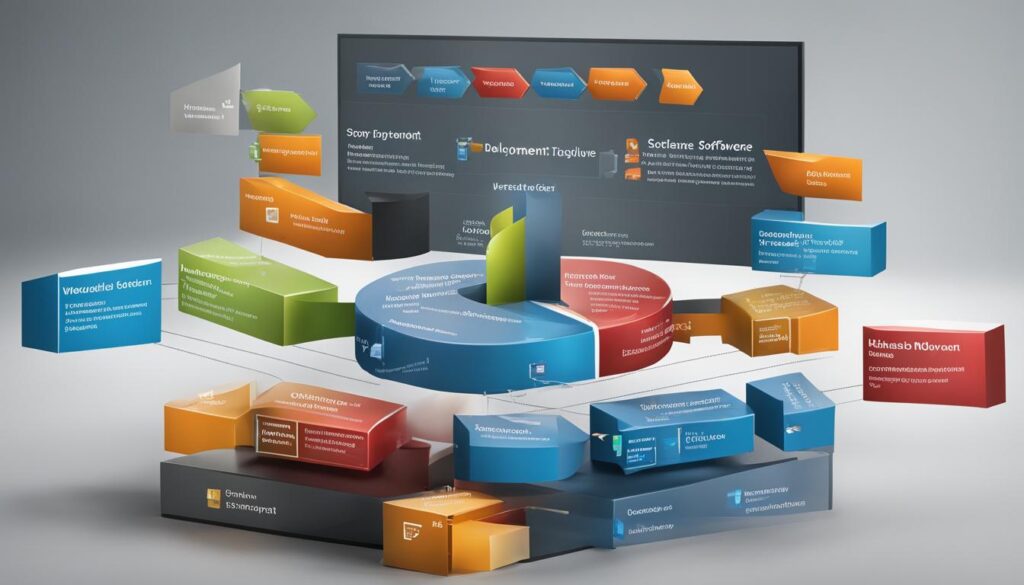Are you curious about what deployment means in information technology? Or maybe you’re looking for a deployment definition to better understand technology deployment? Look no further! In this article, we will dive into the world of IT deployment and unpack its significance in the software development process.
Software deployment encompasses a range of activities, including software release, installation, testing, deployment, and performance monitoring. It involves making a software system or update available to its intended users. Whether done manually or through automated processes, software deployment ensures that developers can deliver updates and new features to users in a timely manner.
Contents
- 1 The Importance of Software Deployment in IT
- 2 Understanding Software Deployment Process
- 3 Different Types of Software Deployment Strategies
- 4 Best Practices in Software Deployment
- 5 Monitoring and Security in Software Deployment
- 6 Combining Deployment with IT Infrastructure
- 7 Conclusion
- 8 FAQ
- 8.1 What does deployment mean in information technology?
- 8.2 What is the importance of software deployment in IT?
- 8.3 What is the software deployment process?
- 8.4 What are the different types of software deployment strategies?
- 8.5 What are the best practices in software deployment?
- 8.6 How do monitoring and security play a role in software deployment?
- 8.7 How can software deployment be combined with IT infrastructure?
- 9 Source Links
Key Takeaways:
- Software deployment is the process of making software available to users.
- It involves activities such as software release, installation, testing, deployment, and performance monitoring.
- Deployment allows developers to deliver updates and new features to users in a timely manner.
- Software deployment is crucial in the IT industry for customer satisfaction and meeting user needs.
- Different types of deployment strategies and best practices can ensure successful software deployment.
The Importance of Software Deployment in IT
Software deployment is a critical aspect of the IT industry as it plays a vital role in ensuring the effective delivery of software updates and new applications to users. It enables developers to respond promptly to customer demand and deliver new features frequently, keeping up with evolving technology trends.
By implementing efficient software deployment strategies, organizations can improve customer satisfaction by providing timely updates and addressing user needs effectively. This not only enhances the user experience but also helps organizations capitalize on economic opportunities and gain a competitive edge in the market.
Furthermore, software deployment streamlines business processes and enhances overall operations and productivity. By automating the deployment process, organizations can save valuable time and resources, reducing manual efforts and the risk of human error. This allows developers to focus on core tasks and innovation, driving business growth and success.
Another crucial aspect of software deployment is ensuring the safety and security of critical processes and sensitive information. By adhering to best practices and deploying software in a controlled and secure environment, organizations can mitigate risks and protect their valuable assets from cyber threats and data breaches.
Types of Deployment Strategies
Organizations have different options when it comes to choosing the right deployment strategy for their specific needs. Two common deployment strategies include:
- On-Premises IT Infrastructure: With this strategy, organizations deploy and manage their software applications on their own physical servers, located on-site. This provides organizations with complete control over their IT infrastructure, allowing for customization and security.
- Cloud-Based Solutions: Cloud-based deployment involves leveraging the infrastructure provided by cloud service providers such as Amazon Web Services (AWS), Google Cloud Platform, or Microsoft Azure. This approach offers scalability, flexibility, and cost-effectiveness, as organizations can leverage the provider’s infrastructure and only pay for the resources they use.
Organizations can choose either on-premises deployment or cloud-based solutions, depending on their specific requirements, resources, and long-term goals. The choice between the two strategies requires careful evaluation and consideration of factors such as scalability, security, and operational costs.
| Deployment Type | Description |
|---|---|
| IT Infrastructure Deployment | Refers to the deployment of software applications on an organization’s own physical servers, located on-site. |
| Software Deployment | Encompasses the process of making software updates and new applications available to users effectively. |
| Application Deployment | Specifically focuses on deploying applications, allowing users to access and use them. |
| System Deployment | Entails deploying an entire system, including hardware, software, and networking components. |
| Network Deployment | Includes the deployment of network infrastructure, ensuring connectivity and data sharing. |
| Hardware Deployment | Refers to the process of deploying physical hardware devices, such as servers or routers. |
As organizations increasingly rely on software applications to drive their operations and stay ahead in the competitive market, the importance of efficient software deployment cannot be overstated. It not only enables organizations to deliver updates and new features promptly but also enhances operational efficiency, productivity, and security.
Understanding Software Deployment Process
The software deployment process consists of three general phases: preparation, testing, and deployment. Each phase is essential in ensuring the successful release of software updates and new applications.
Preparation
During the preparation phase, developers gather all the necessary code, libraries, and resources for the application to function. This includes identifying and resolving any dependencies, ensuring compatibility with the target environment, and preparing the necessary documentation.
Key steps in the preparation phase:
- Gathering code, libraries, and resources
- Resolving dependencies
- Ensuring compatibility
- Preparing documentation
Testing
The testing phase is crucial to ensure the proper functioning of the software update or application. During this phase, the update is deployed to a test environment where automated tests are performed. These tests help identify and fix any issues or bugs before the update is released to the live environment.
Key steps in the testing phase:
- Deploying to a test environment
- Performing automated tests
- Identifying and fixing issues
Deployment
Once the software update has been fully tested and deemed ready for release, it can be deployed to the live environment. Continuous integration and continuous deployment methodologies play a significant role in streamlining the deployment process and ensuring the delivery of high-quality code.
Key steps in the deployment phase:
- Deploying the update to the live environment
- Ensuring proper functioning
Continuous Integration and Continuous Deployment
Continuous integration (CI) and continuous deployment (CD) are methodologies that aim to automate and streamline the software deployment process. CI involves continuously merging code changes from multiple developers into a shared repository, allowing for frequent integration and testing. CD takes this a step further by automating the release and deployment of code to production environments.
The benefits of CI/CD include:
- Rapid feedback on code changes
- Improved collaboration between developers
- Reduced deployment risks
- Increased efficiency and productivity

This image illustrates the software deployment process, encompassing the three phases of preparation, testing, and deployment. It visually represents the flow and interconnectedness of these phases, highlighting the importance of each step in ensuring a successful deployment.
Different Types of Software Deployment Strategies
When it comes to software deployment, organizations have the flexibility to choose from various strategies based on their specific needs and requirements. Each strategy offers its own advantages and considerations. Let’s explore some of the most common software deployment methods:
- Network-based deployment: This method connects IT devices to release software updates and new applications. It utilizes an established network infrastructure to distribute the software to targeted devices.
- Agent-based deployment: In agent-based deployment, software is deployed using an internet connection. Agents, installed on target devices, communicate with a central management system to facilitate the deployment process.
- Basic deployment: Basic deployment involves updating all target environments simultaneously. This approach ensures that every user has access to the latest version of the software. It is commonly used for smaller deployments with a limited user base.
- Rolling deployment: Rolling deployment gradually replaces the old version of the software with the new one, minimizing disruption and allowing for a smooth transition. This method is particularly useful for larger deployments and mission-critical systems.
- Blue/green deployment: With blue/green deployment, two versions of the application are run simultaneously – the “blue” version (currently live) and the “green” version (latest update). Traffic is gradually redirected to the green version, providing a seamless transition for end-users.
- Canary deployment: In canary deployment, updates are incrementally deployed to small groups of users before a full-scale deployment. This allows organizations to gather feedback and identify potential issues before rolling out the update to all users.
- Multi-service deployment: Multi-service deployment involves the simultaneous update of multiple services or components within a system. This approach ensures that all interconnected services are updated and compatible with each other.
- Shadow deployment: Shadow deployment releases parallel versions of the software to test performance and stability. The shadow version runs alongside the production version, allowing organizations to assess the impact of the new deployment without affecting end-users.
Each software deployment strategy offers unique benefits and considerations. Organizations should carefully evaluate their requirements, user base, and system complexity to determine the most suitable deployment method.

Best Practices in Software Deployment
To ensure successful software deployment, it is crucial for organizations to follow a set of best practices. By doing so, you can minimize risks, improve efficiency, and deliver high-quality software updates and applications to your users. Below are some best practices and checklists for each phase of the software deployment process: preparation, testing, and deployment.
Preparation Checklist
During the preparation phase, it is important to cover all essential aspects to ensure a smooth deployment process. Consider the following checklist:
- Notify stakeholders about the upcoming deployment.
- Inform collaborators, such as developers and testers, about their roles and responsibilities.
- Check third-party software requirements and ensure compatibility.
- Map out the deployment process, including timelines and dependencies.
- Create a rollback plan in case of any unforeseen issues.
- Establish key performance indicators (KPIs) for evaluating the success of the deployment.
Testing Checklist
Thorough testing is critical to detect and address any issues before deploying software to the live environment. Use the following checklist to ensure comprehensive testing:
- Conduct unit tests to validate individual components.
- Integrate testing with Continuous Integration (CI) tools for seamless automated testing.
- Create a staging environment that closely resembles the production environment for realistic testing.
- Run end-to-end tests to verify the functionality and integration of the software.
- Seek feedback from stakeholders, including users, to gather insights and identify potential issues.
- Perform smoke tests to quickly validate the basic functionality of the deployed software.
Deployment Checklist
When it comes to the deployment phase, it is essential to have processes and checks in place to ensure a successful deployment. Here’s a checklist to guide you:
- Monitor the performance and health of the deployed software to identify any issues or bottlenecks.
- Automate rollbacks to revert to the previous version in case of any critical failures.
- Regularly check the environment health, including server capacity and network resources.
- Keep track of logs and error messages to troubleshoot issues efficiently.
- Document the deployment process, configurations, and any customizations for future reference.
Adhering to these best practices and checklists will help ensure a smooth software deployment process, minimize risks, and deliver high-quality software updates and applications to your users.

**Table: Best Practices Checklist**
| **Phase** | **Best Practices** |
|——————|——————————————————————————————————————————————————————————————————————————————————————————|
| Preparation | – Notify stakeholders
– Inform collaborators
– Check third-party software requirements
– Map out the deployment process
– Create a rollback plan
– Establish KPIs |
| Testing | – Conduct unit tests
– Integrate testing with CI tools
– Create a staging environment
– Run end-to-end tests
– Seek stakeholder feedback
– Perform smoke tests |
| Deployment | – Monitor performance
– Automate rollbacks
– Check environment health
– Keep track of logs
– Document the deployment process |
(Source: Author’s own compilation)
Monitoring and Security in Software Deployment
Monitoring and security play a crucial role in ensuring the success of software deployment. By implementing robust monitoring and security capabilities, developers and IT organizations can effectively monitor the performance and security of deployed software applications. One tool that stands out in providing comprehensive network monitoring and security is Sumo Logic.
Sumo Logic is a powerful platform that enables real-time data analysis and operational visibility. With its advanced features, it helps developers and IT professionals streamline error detection, optimize performance, and enhance the overall user experience. By gathering real-time operational and performance data, Sumo Logic allows teams to proactively identify and resolve issues, ensuring the proper functioning of the deployed software.
Sumo Logic’s network monitoring capabilities provide a comprehensive view of the network infrastructure, enabling organizations to detect anomalies, troubleshoot problems, and ensure smooth operations. It offers deep visibility into network traffic, allowing IT teams to monitor network performance, identify bottlenecks, and optimize resource allocation.
When it comes to security, Sumo Logic offers robust features to protect deployed software applications and sensitive data. It helps organizations detect and respond to security threats, allowing proactive measures to prevent unauthorized access and potential breaches. With Sumo Logic, IT teams can gain insights into security events, perform real-time threat detection, and implement effective security measures.
“Sumo Logic provides powerful monitoring and security capabilities that help organizations ensure the proper functioning and security of their deployed software applications.”
Benefits of Monitoring and Security in Software Deployment
Implementing monitoring and security capabilities during the software deployment process offers numerous benefits:
- Timely issue detection and resolution: Real-time monitoring allows organizations to identify performance issues and security threats promptly, enabling faster resolution and minimizing potential downtime.
- Improved user experience: By monitoring performance metrics, organizations can optimize the user experience, ensuring smooth and efficient software operation.
- Enhanced security: Robust security capabilities help protect sensitive data and prevent unauthorized access, ensuring the integrity of deployed software applications.
- Proactive threat detection: Monitoring tools like Sumo Logic allow organizations to detect security threats in real-time, enabling them to respond promptly and prevent potential breaches.
- Operational efficiency: Monitoring and security capabilities streamline error detection and correction processes, improving overall operational efficiency and reducing manual efforts.
By incorporating monitoring and security into software deployment processes, organizations can ensure the continuous operation of their applications, maintain data confidentiality, and provide a seamless user experience.
Network Monitoring and Security Capabilities: A Comparison
Let’s compare the network monitoring and security capabilities of Sumo Logic with other leading tools:
| Tool | Network Monitoring Capabilities | Security Capabilities |
|---|---|---|
| Sumo Logic | Provides comprehensive network visibility and performance monitoring. | Offers real-time threat detection and proactive security measures. |
| Tool X | Limited network visibility and basic performance monitoring. | Basic security features, lacking real-time threat detection. |
| Tool Y | Advanced network monitoring capabilities with customizable dashboards. | Robust security features, including AI-driven threat detection. |
As we can see, Sumo Logic excels in both network monitoring and security capabilities, providing organizations with a comprehensive solution to monitor and secure their deployed software applications.
Incorporating Monitoring and Security into Your Software Deployment
To ensure effective monitoring and security in software deployment, consider the following best practices:
- Choose a robust monitoring and security tool: Select a tool that offers comprehensive monitoring and security capabilities, such as Sumo Logic, to ensure the proper functioning and security of your deployed software applications.
- Define key performance indicators (KPIs): Establish KPIs that align with your organization’s goals and objectives, allowing you to measure the success of your software deployment and monitor performance.
- Implement real-time alerting: Configure alerts to notify you of any performance issues or security threats in real-time, enabling prompt action and resolution.
- Regularly update your monitoring and security configurations: Stay up-to-date with the latest features and security patches provided by your monitoring and security tool, ensuring optimal protection and performance.
- Monitor and analyze performance metrics: Continuously monitor and analyze performance metrics to identify areas for improvement and optimize the user experience.
- Conduct regular security audits: Regularly assess and audit your software deployment’s security posture to identify vulnerabilities and implement necessary security measures.
By following these best practices and leveraging powerful monitoring and security tools like Sumo Logic, you can ensure the successful deployment, performance, and security of your software applications.
Combining Deployment with IT Infrastructure
When it comes to software deployment, organizations have the option to combine it with various types of IT infrastructure. This includes both on-premises infrastructure and cloud services provided by leading companies such as Amazon Web Services (AWS), Google Cloud Platform, and Microsoft Azure. By leveraging these IT infrastructure options, organizations can optimize their software deployment processes and achieve greater efficiency and scalability.
Cloud-based solutions, such as Infrastructure as a Service (IaaS) and Platform as a Service (PaaS), offer developers the ability to deploy applications into live environments without the burden of managing their own servers. This allows organizations to focus on their core business functions, reduce capital expenditure, and benefit from the scalability and flexibility offered by cloud service providers.
Benefits of Combining Deployment with IT Infrastructure
- Scalability: Cloud service providers offer the ability to scale resources up or down based on demand. This ensures that organizations can easily handle fluctuations in user traffic without compromising on performance.
- Flexibility: With cloud-based infrastructure, organizations have the flexibility to choose the services and resources that best suit their needs. They can quickly provision and deprovision resources as required, enabling agility in software deployment.
- Cost-effectiveness: By leveraging cloud services, organizations can avoid the upfront costs associated with purchasing and maintaining hardware. They only pay for the resources they use, resulting in cost savings and improved financial efficiency.
Whether organizations opt for on-premises infrastructure or cloud-based solutions, combining deployment with IT infrastructure is essential for successful software deployment. It allows organizations to leverage reliable infrastructure, embrace modern technologies, and stay competitive in the rapidly evolving digital landscape.

Conclusion
In conclusion, software deployment is a vital process in the field of information technology. It ensures the efficient delivery of software updates and new applications to users, enabling organizations to meet customer demand and enhance their operations. By deploying software frequently, businesses can stay ahead of the competition and deliver new features that cater to user needs.
There are different types of deployment strategies that organizations can employ, such as network-based deployment, agent-based deployment, and rolling deployment. It is crucial to follow best practices during the software deployment process, including thorough preparation, rigorous testing, and effective monitoring. By implementing these best practices, organizations can minimize risks, ensure the smooth functioning of their software applications, and maintain the security of their systems.
Monitoring and security tools, like Sumo Logic, play a pivotal role in software deployment. These tools help developers and IT organizations monitor the performance and operational metrics of deployed software applications. Additionally, combining software deployment with various IT infrastructure options, such as on-premises infrastructure or cloud-based solutions, provides scalability, flexibility, and cost-effectiveness for organizations.
FAQ
What does deployment mean in information technology?
Deployment, in the context of information technology, refers to the process of making a software system or update available to its intended users. It involves activities such as software release, installation, testing, deployment, and performance monitoring.
What is the importance of software deployment in IT?
Software deployment is crucial in the IT industry as it ensures that software updates and new applications are delivered to users effectively. It allows developers to respond quickly to customer demand, meet user needs, streamline business processes, enhance operations and productivity, and ensure the safety of critical processes and sensitive information.
What is the software deployment process?
The software deployment process consists of three general phases: preparation, testing, and deployment. During the preparation phase, developers gather all the necessary code, libraries, and resources for the application to function. In the testing phase, the update is deployed to a test environment and subjected to automated tests to ensure its proper functioning. Once the update is fully tested, it can be deployed to the live environment.
What are the different types of software deployment strategies?
There are various types of software deployment strategies that organizations can use. Some of the common strategies include network-based deployment, agent-based deployment, basic deployment, rolling deployment, blue/green deployment, canary deployment, multi-service deployment, and shadow deployment.
What are the best practices in software deployment?
To ensure successful software deployment, organizations should follow best practices, such as notifying stakeholders, performing unit tests, creating a staging environment, automating rollbacks, monitoring performance, and keeping track of logs. Documentation is also important for maintaining consistency and facilitating future changes.
How do monitoring and security play a role in software deployment?
Monitoring and security are critical aspects of software deployment. Tools like Sumo Logic provide network monitoring and security capabilities that help developers and IT organizations ensure the proper functioning and security of deployed software applications. These tools gather real-time operational and performance data, streamline error detection and correction, and enhance the overall user experience.
How can software deployment be combined with IT infrastructure?
Software deployment can be combined with various types of IT infrastructure, including on-premises infrastructure and cloud services provided by companies like Amazon Web Services (AWS), Google Cloud Platform, and Microsoft Azure. Cloud-based solutions offer scalability, flexibility, and cost-effectiveness, allowing organizations to focus on their core business functions while relying on reliable infrastructure for software deployment.




